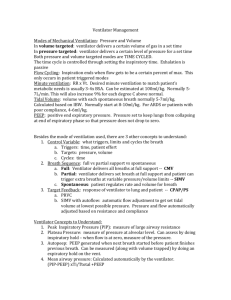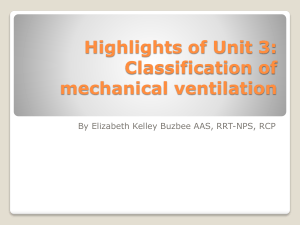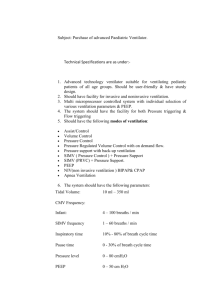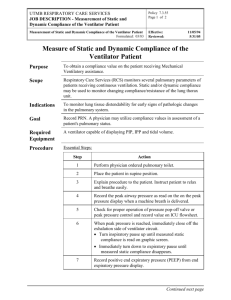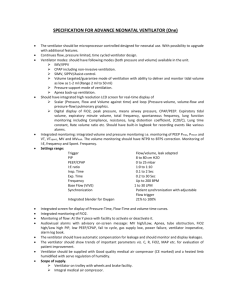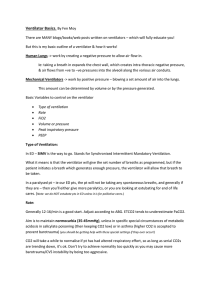754TrainingPresentation no plat
advertisement
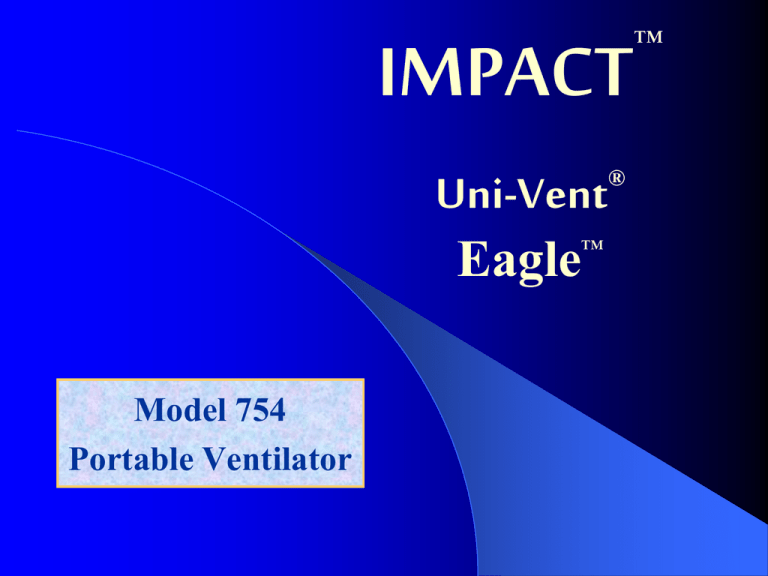
IMPACT Uni-Vent ® ™ Eagle Model 754 Portable Ventilator ™ Uni-Vent® Eagle™ Model 754 Portable Ventilator OPERATOR TRAINING PROGRAM FOR: Critical Care Transport Aero medicine Emergency Services Uni-Vent® Eagle™ Model 754 Portable Ventilator Features Microprocessor control of all functions including automatic monitoring of internal battery and external power sources, internal compressor and external gases. Extensive alarm monitoring of operating, non-operating and advisory conditions. Contemporary design to facilitate transport and placement. Gas-efficient electronic control circuitry eliminates all pneumatic-logic circuits, and any dependency on gas for operating power. Rechargeable batteries, fully compatible with vehicular electrical systems and airborne environments. Uni-Vent® Eagle™ Model 754 Portable Ventilator Features Cont…. Fully self-contained, may be operated without attachment of external gas(es) and/or external power. Numerical panel markings indicate sequence-ofoperation steps to simplify and speed start-up. Graphics display includes 12-second pressure waveform. Its amplitude is calibrated to the adjacent digital bar graph. Automatically compensates pressure transducer to altitude-related barometric pressure changes up to 25,000 ft. Your Uni-Vent Eagle ® Portable Ventilator • Internal or External Power • Internal Compressor • Internal Air/Oxygen Mixer • Software-generated PEEP • Single-Patient-Use Circuit • Fast Start-Up • For use with Adults, Children, Infants ™ Uni-Vent Eagle™ ® Internal or External Power Internal Power External Power External Power Supply Uni-Vent Eagle™ ® Uses internal Compressor and/or external gas(es) with internal Blender Air Oxygen Air/Oxygen Mixer Manifold Internal Compressor CPU To Patient Getting started, the basics… • Ventilator circuit set-up • Selecting a mode of operation • Setting a ventilatory rate • Setting an inspiratory time, or I:E ratio default • Setting a tidal volume • Setting an FI02 • Setting High and Low Limit Pressure alarms Ventilator circuit set-up • Connect 22mm corrugated hose to ventilator GAS OUT fitting • Connect green TRANSDUCER HOSE to ventilator TRANSDUCER hose barb (Green) • Connect clear EXHALATION VALVE HOSE to Ventilator EXHALATION VALVE hose barb (clear) The basics… Select a Mode of operation Set a Ventilation Rate Set an Inspiration Time, or I:E Ratio default Set a Tidal Volume Set an FI02 Set the High and Low Limit Pressure Alarms Additional functions… • External Air • Sigh • PEEP • Pressure Plateau • Manual Breath/Trigger • Alarm Mute/Cancel • Apnea Backup (Automatic) Additional functions… External Air • External Air The EXTERNAL AIR Pushbutton Switch permits you to manually select external compressed air as your primary air source. When the ventilator is turned ON, its CPU "samples" the respective gas fitting and looks for an air pressure, greater than 40-PSI. If a lower pressure, or no pressure is sensed, the LCD will display "OFF" (default value) and the CPU allows operation to begin from the internal compressor. If a pressure exceeding 40-PSI (+/- 2 PSI) is sensed, the LCD will display "ON" and allow operation to begin from the external air supply. Manually pressing the pushbutton will toggle the display from "OFF" to "ON or from "ON" to "OFF". Additional functions… SIGH • SIGH The SIGH OFF/ON Pushbutton Switch permits the ventilator to operate with or without SIGH. When the SIGH function is activated, the first ventilator-generated breath is always a SIGH. Afterwards, each additional SIGH breath is delivered once every 100 breaths or 7-minutes, whichever occurs first. A SIGH breath equals 150% of the INSPIRATION TIME setting (and the exhalation period). This will increase the delivered volume of that breath by 50%. By proportionately increasing both the inspiration and exhalation time, Uni-VentTM maintains the I:E ratio for all breaths. As a safety precaution, Uni-VentTM will not allow the inspiratory portion of a SIGH breath to exceed 3 seconds. Additional functions… PEEP • PEEP The PEEP OFF/ON-SET Value Pushbutton Switch activates Uni-VentTM's internal PEEP learning software. When the ventilator is turned ON, PEEP has a default value of 0 cmH2O (no PEEP). Each time the pushbutton is pressed, PEEP is increased by 1 cmH2O up to a maximum value of 20 cmH2O (then back to “0” again). It may take several breaths for the learning process to conclude. During this period you will see a PEEP value successively added to the pressure waveform after each breath. To protect against high airway pressures, UniVentTM will “dump” PEEP (to 0 cmH2O) if the patient should cough. Additional functions… Manual Breath/Trigger • Manual Breath/Trigger The MANUAL BREATH/TRIGGER Pushbutton Switch delivers a manual breath each time the pushbutton switch is pressed. The inspiratory time and tidal volume of each manual breath is equal to the current control settings. If a ventilator failure occurs, the operator can manually trigger a continuous flow of gas can be triggered for as long as the pushbutton switch is pressed. Additional functions… Mute/Cancel Pushbutton • Mute/Cancel The MUTE/CANCEL Pushbutton Switch allows the operator to temporarily mute the audible component of an Operating Alarm or cancel the audible and flashing LED Alarm Indicator components of an Advisory Alarm. Most mute periods are 30-seconds long. An External Power Low/Failure Alarm mute will last for 5minute intervals until a Low Battery Alarm occurs and for 30-second intervals thereafter. The LCD Screen what you can see… • Control settings • EXTERNAL AIR, SIGH, PEEP, PLATEAU and PRESSURE ALARMS settings are displayed under their respective controls. • VENTILATION RATE, INSPIRATION TIME/I:E RATIO, TIDAL VOLUME and AIR / OXYGEN MIXER settings are displayed above their respective controls. The LCD Screen what you can see… Cont…. ALARM MESSAGE CENTER (AMC): The centralized location for displaying up to 4 lines of alarm message information. MODE and Vmin indicators: Displays operating mode and minute volume (A/C Mode). Inhalation/Exhalation indicator: Alternately displays the inspiration and exhalation phase of mechanical and/or spontaneous breaths. BATTERY and EXTERNAL POWER source indicators: 2-line area that displays the current status of external power, internal power, and fuses. The LCD Screen what you can see… Cont…. Peak & Mean inspiratory pressures are displayed after each breath The digital bar graph displays peak pressure during each breath High and Low Pressure Limit Alarm setting “tics” are continuously displayed 6-second’s of pressure wave form data, including PEEP is displayed Set and Delivered tidal volume are alternately displayed Thank You! Email: gbeck@impactii.com

